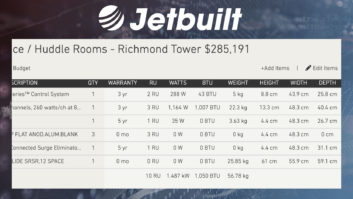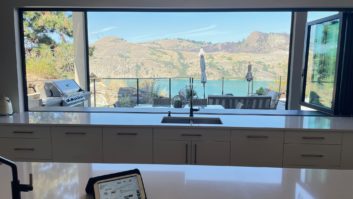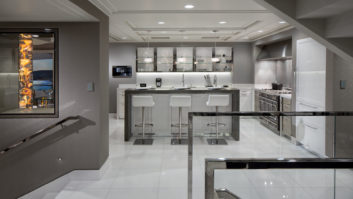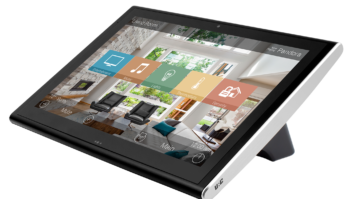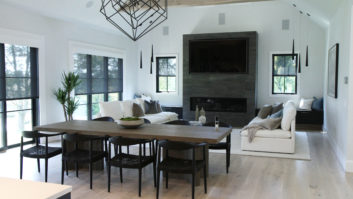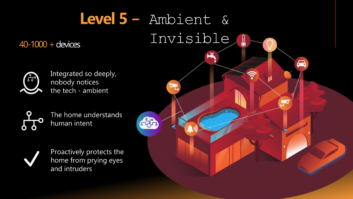Some of my first HVAC controls experiences taught me good lessons in working with other trades. Before there were communicating thermostats, we would link HVAC equipment with a separate central controller and write our own thermostat-like algorithms.
Normal operation occurred from a touch screen, though a standard mechanical thermostat provided backup via a switchover in the mechanical room. Because HVAC contractors knew very little about our system, any problems were blamed on that “darn computer” that could not be trusted. I spent hours going to job sites proving to the homeowner and the contractor that the problem was in the equipment not the controls.
I realized that this was not very profitable for the contractor or me. Today, with communicating thermostats, HVAC control is back where it belongs. The HVAC contractor installs and maintains the mechanical systems and thermostats as a standalone sub-system. The added communications features allow external home control systems to monitor thermostat activity and request a change such as temperature set point. The clear dividing line is between the thermostat and the external controller, and not in the middle of the HVAC contractor’s responsibility.
As with any subsystem that you integrate with a home control system, it is important to have a basic understanding of the features, operation and options of the subsystem. As such, you will need to understand the basics of HVAC to work with the contractor and specify the right communicating thermostat-one that matches the heating/cooling equipment that they have specified as well as your equipment and applications.
HVAC Equipment and Systems One of the more common central heating and cooling systems in use today is the split system. An indoor unit and an outdoor unit splits the HVAC equipment components. The indoor unit houses the air-handling unit, evaporator cooling coil and heater/furnace. The outdoor unit completes the refrigeration side of the system and includes the compressor, condenser and a condenser fan. A split system may be either a straight heat/cool or a heat pump. In a straight heat/cool application, the indoor unit includes a separate furnace. The refrigeration side operates to exchange heat from inside the house to outside via the outdoor unit.
A heat pump operates the same as straight heat/cool systems when in cooling operation. Heating operation, however, is a different story. By reversing the refrigeration cycle, the heat pump extracts heat from the outside air and carries it to the indoor unit for distribution. These air-to-air type heat pumps offer energy efficient solutions in more moderate southern climates where the temperature seldom gets below freezing. An auxiliary heater (typically electric strips) is included with the indoor unit for those colder nights when the system cannot keep up.
In colder climates, the geothermal/ground source type heat pumps are gaining in popularity. Rather than an air-to-air heat exchange, deep-water wells or piping buried in a grid well below ground’s freeze line provide a more temperate zone to exchange the heat in both cooling and heating modes. While very efficient and inexpensive to operate, these systems can be expensive to install.
Radiant systems provide heat by means of hydronic piping or electric mats usually embedded in floors. Hydronic systems require a boiler to heat the water solution and pump to circulate the fluid through the piping. Electric systems used heated elements resembling those used in electric blankets.
With few exceptions, the controls, whether it is a heat pump, radiant floor heat or straight heat/cool system, follow very similar principals.
Thermostat Basics:
Everyone has used a basic thermostat at one time or another. It may have been round with a dial or square with sliders or electronic with a display. Their basic principal involves a temperature sensor to determine room or ambient temperature. This is compared to a desired temperature setting (set point). In heating, for example, the thermostat will switch “On” one or two degrees below the set point and “Off” one or two degrees below the set point. This deadband range (often adjustable) keeps the HVAC system from cycling on/off too frequently.
The thermostat base has various wiring connections depending on whether the HVAC system is of the single stage, multi-stage or heat pump variety. Except for a few special applications, thermostats all use 24-VAC switching. In a single-stage application, the 24-VAC power at the R terminal is switched to operate the fan relay (G terminal) and engages either the heater/furnace (W terminal) or the cooling compressor (Y terminal).
The heating or cooling has a single “On” stage. Single-stage thermostats are also referred to as four-wire thermostats (R, G, W and Y) though electronic versions also require the 24-VAC common (X or C terminal) to power the internal electronics.
A multistage system allows switching for multiple levels of heating or cooling. For example, a thermostat for a two-stage cooling system would switch the Y1 terminal to operate the compressor in the low speed mode. If the ambient temperature was not falling fast enough (e.g. it is really hot outside), then the Y2 terminal is switched in to boost the speed to “High.”
A heat pump thermostat adds the B and O terminals to operate the four-way valve that reroutes the refrigerant flow and reverses the refrigeration cycle. The E terminal activates the auxiliary heat when the heat pump cannot keep up. Radiant systems typically use single-stage thermostats. The heat terminal activates the boiler/pump or solenoid valve in hydronic systems and power relays in the electric versions.
Working with HVAC Controls:
Going beyond the “stat-on-the-wall” that any HVAC contractor can install is possible. Today’s manufacturers offer configurations and options that include remote sensors, zoning and networked communications. Locating a thermostat for the best reading from its integral temperature sensor is not always the most useful or aesthetically pleasing location. Smaller remote sensors (some can even be embedded in the wall and totally hidden) can often solve this problem. By placing the sensor where the thermostat would normally go, the thermostat itself can be relocated.
In some applications, I have co-located all of the thermostats in one area for ease of use. Some product offerings allow connection of multiple sensors to one thermostat. This is useful where it may desirable to monitor outdoor temperature or average multiple sensors in a large space. Additional remote sensor possibilities include monitoring of outdoor and indoor humidity.
Zoning extends control to two or more areas from the same HVAC unit. Airflow to zoned areas is controlled by motorized dampers inserted inline in the supply ductwork. Basic four-wire thermostats placed in each zone initiate a “call” for heating or cooling (e.g. 24VAC on the W or Y terminal) as needed. A compatible zone control panel controls the HVAC unit and opens or closes the appropriate dampers based on the thermostats’ call signals.
Enhancing thermostats with communications provides options for external control and monitoring, alleviating the need to go to the thermostat to make adjustments. This communication can be as simple as a switch closure.
For more sophisticated applications, two-way communications between the external control system the thermostats provides full control and monitoring. Products are available that provide a wide range of communication options and interfaces, including RS-232, RS-485, ethernet, X-10 and LonWorks. Integration with home automation controllers can bring the benefit of centralized control from touchscreens, PCs or voice command.
A Mother’s Request:
Several years ago, I installed some X-10 lighting control for my mother. I included a universal remote that not only controlled her A/V but the X-10 lights as well. Beaming, I showed her the new setup with the convenience of operation from her comfortable chair. In, turn she remarked, “This is great! Now how do I adjust my temperature? Sometimes I get a little chilly.” With an air of practicality I replied, “Jeez Mom, it’s only 10 steps down the hall to the thermostat.” To which she cleverly noted, “It’s less than that to my TV, and I can control that from here…not to mention the lights.” Hmmm, maybe she had a point. I’m still working on the solution.”
Michael Cogbill ([email protected]) is consultant in Solana Beach, CA.
